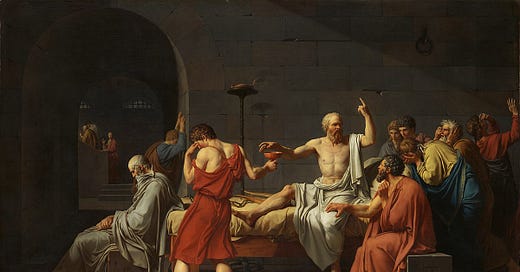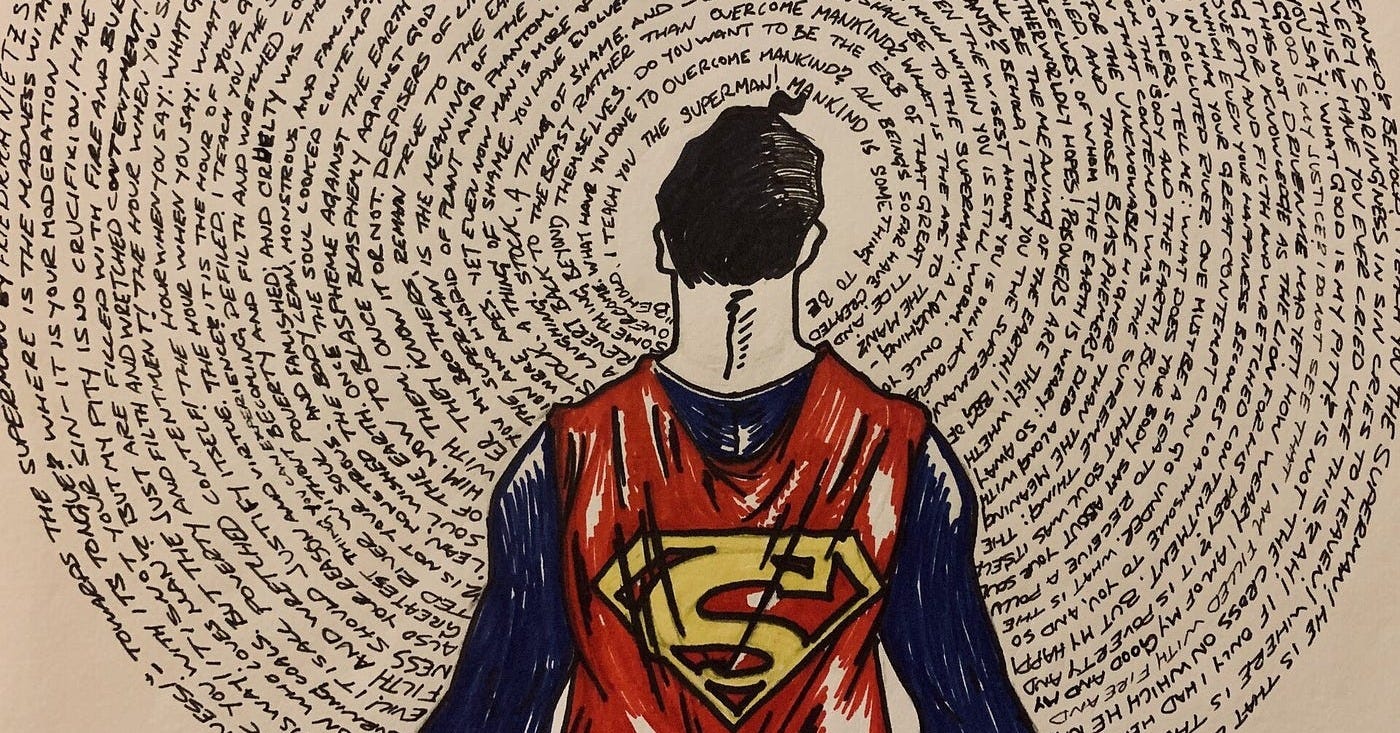In the last part we talked about how the allegory of the Cave ties into the ancient mystery schools. Within this article I will go deeper into the implications of it. When it comes to Plato's allegory of the Cave, it symbolizes this journey toward understanding the Forms. The shadows on the wall, cast by objects outside the cave, represent the illusions and partial truths we perceive in our everyday lives. These shadows are akin to the projections of unconscious content onto the world, much like the images and spirits ancient shamans sought to understand. To step out of the cave and into the light of the sun, the source of illumination in Plato's analogy, is to awaken to the reality of the Forms, leaving behind the distortions of perception and the confines of ignorance.
Yet, it is crucial to note that Plato’s emphasis on the Forms subtly shifts the focus from the gods and myths of earlier traditions to a more abstract and universal metaphysical framework. This evolution reflects a broader trend in Western thought: the transition from mythos to logos, from symbolic storytelling to rational inquiry. However, the essence of the process remains the same, the search for truth, the peeling away of illusion. This brings us back to the scientific method. Like the philosophical pursuit of the Forms, the scientific method seeks to move beyond the "shadows on the wall" to uncover the underlying principles that govern reality.
Like the allegory of the Cave and the process of seeking the Forms, also the Socratic method embodies a journey of peeling away illusions to reveal deeper truths. However, where Plato’s Forms emphasize metaphysical realities, the Socratic method focuses on the process of critical dialogue and self-examination as the path to wisdom. The Socratic method, as practised by Socrates, is an iterative and dialogical approach that relies on asking probing questions to challenge assumptions and reveal contradictions in thought. This process helps the individual move closer to a more coherent and accurate understanding of the subject at hand. It is not about providing definitive answers but about cultivating an ongoing openness to deeper inquiry.
Similarly the peer review process in science is a form of collective, iterative inquiry akin to Socratic dialogue, where one is forced to confront biases and unconscious drives. This ties into the same inner process that occurs. Where for the initiate into the mysteries this was tied to a mythological lens and deities that represent the death and rebirth cycle and the coming together of dualities into a singular figure symbolised by Bacchus, which was similarly predicated in teachings that helped them through the slow state of ignorance and projections onto the world, as if the gods were mere external constructs, it forced them inward. To understand that the gods were not external beings, but symbols of deeper truths about the nature of reality and consciousness. In that sense the gods were and are symbols for codified behaviour routines, explained through the symbolism and narrative of the deity.
Think how the Sovereignty Goddess for instance symbolised the idea of sovereignty, yet also codified the behaviour routine of how a leader was to act. She was tied symbolically to the well-being of the land and the people. The elaborate rituals and the rite of passage that any leader had to undergo to even become a leader where all about instilling the proper behaviour routine within the person, so they would internalise the behaviour routine of a good leader. Similarly Bacchus tied to the death and rebirth process is both symbolic of the seasons and the death and renewal of nature, yet also tied to the process of both psychological and societal renewal. In a deeper sense it is about facing the metaphorical snake of chaos, and through wisdom and understanding turning it into a force for healing and renewal.
The Process of Finding Wisdom
The process within the ancient mysteries were about this process of integrating the emotional, instinctual and general unconscious drives of human nature, so they were not merely externalised as gods or symbols that merely govern life, but internally understood as a reflection of the psyche. The scientific method similarly through the process itself and the peer review system is to bring about this same process of integrating the emotional, instinctual and general unconscious drives of human nature, so we can work through our illusions and with this understand aspects of reality. Human consciousness can project onto the world things which are internal to it, and due to which our own biases, and the unconscious human drives that govern our behaviour due to anything from trauma to just general cultural or research blind spots, we obscure the true nature of reality. We can only come to an objective understanding by working through it.
Olympiodorus, the Neo-Platonic Philosopher also regarding this said “At the start, our irrational side is like the Titans, destroying our rational and higher self. When we neglect our intuitive intellect, which is hidden within us and connects us to both the lower and higher aspects of ourselves, we become like the Titans (or traitors to ourselves). But when we align ourselves with this intuitive aspect, we become like Bacchus, in control and in harmony with our irrational side.” This is where the scientific method builds upon the ancient ideas of the mystery schools, as it fosters through its method and peer review system, the same process of working through the emotional, instinctual and general unconscious drives of human nature.
It forces these into consciousness, and with it removes illusions that hinder our understanding of reality and truth. This process itself ranging from the ancient cave rituals, through even the later initiation rituals for men and women like the Koryos warrior ritual (which was to instil the behaviour routine for leadership), or the Arkteia rite of passage for women, and finally also the mystery schools that were born out of these ancient rites, have the same purpose. By having people undergo this process it does not only allow people to work through these emotional, instinctual and general unconscious drives of human nature, and any tied illusions that can come with it, yet it also removes the need to externalise this onto the world. Let this be a deity or spirit, or even a specific individual when it comes to scapegoating. As this process itself removes the need for a scapegoat to have to initiate the process of renewal alone, and point out the illusions of the tribe, which often leads to the death of this person. In this sense the scientific method becomes a process of the democratisation of the process of renewal and working through the illusions of the psyche, to get to a better understanding of reality and truth, without the need for death and violence, nor the need for a singular person needing to carry the singular burden of a Christ-like figure.
The Consequences of Neglecting the Process
If we however fail to work through the emotional, instinctual and general unconscious drives of human nature through this iterative process of the scientific method, and tie this to a fixed ideology with particular outcomes in mind, we actually hinder the process of unveiling reality and truth, and with it hindering our understanding of things. Which actually ultimately hinders the value and impact it could have, and the actual good it could do. So whilst science can do good, and can have benefits for society and societal renewal, thus furthering social progress, this can not be divorced from the integrity of the scientific method itself. If we tie this instead to policy-driven research or a particular ideology, we end up implicitly defining that we already have understood truth in its entirety. The ideology and policy whilst seemingly noble in its pursuits, similarly can be blind to things, and have its illusions that it takes for truth.
As with any ideology or even new philosophy being created by someone, such as for instance a Nietzsche, contain a larger historical and societal context that have to be taken into account. Which includes the personal history of the person. Nietzsche’s early life was marked by significant trauma and loss. His father died when he was just five years old, and his mother, with whom he was very close, became his primary caregiver. Nietzsche’s own health problems and the feeling of abandonment and isolation can be seen as reflective of the wounded inner child.
His works grapple with themes of suffering, abandonment, and a quest for meaning amidst personal pain. His later philosophical work can be seen as an attempt to transcend the limitations imposed by these early traumas, seeking to transform his suffering into a source of strength through the concept of the Übermensch. That is why he also struggled with the feminine principles of life. Feeling cut off from the love he needed as a child, splitting women into both good and bad. That is why he clung onto the Ubermensch. The strong one. It was a compensation for him. The strong one role is a persona and role often taken up by people who are scapegoat-identified in an unconscious manner.
Nietzsche’s exploration of the Apollonian and Dionysian forces was central to his philosophy, particularly in works like The Birth of Tragedy. The Apollonian for him represented order, rationality, and form, while the Dionysian embodied chaos, ecstasy, and primal drives. Where in Beyond Good and Evil, Nietzsche critiques the binary opposition of good and evil imposed by traditional moral systems. Trying to work through the scapegoat-redeemer split, symbolized by both the Apollonian and Dionysian, as much by Good and Evil. Yet he struggled to find a stable synthesis. Apollo being redeemer in myth, and Dionysus the one dismembered and cast out as a wanderer deity. His writings were an attempt for him to work through the underlying emotional, instinctual and general unconscious drives. In this same way this applies to all thinkers, and thus any ideology and thus policy-driven ideas. They are all subject to the same human drives, and when unexamined and not thoroughly going through the scientific method within an institution like a university this is like putting blinders on a horse.
In the next part we will go deeper into scapegoat and redeemer next to the death and rebirth cycle, and how this ties into the quest for Truth and understanding.






